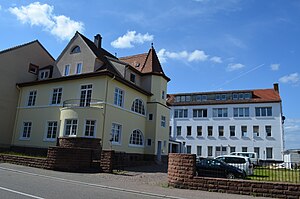German shoe school
| German shoe school | |
|---|---|

|
|
| In the background the first building of the shoe school from 1927 to 1936 | |
| type of school | Technical school |
| founding | 1927 |
| place | Pirmasens |
| country | Rhineland-Palatinate |
| Country | Germany |
| Coordinates | 49 ° 11 '26 " N , 7 ° 36' 15" E |
| Website | www.deutsche-schuhfachschule.net |
The German Shoe School (DSF), based in Pirmasens, is a state technical school for training shoe technicians in the fields of industrial engineering and model design.
history
The German shoe school was founded in 1927 as an independent "technical school of the German shoe industry" and was the second attempt at a shoe school in the German Reich , after the Prussian technical school in Wermelskirchen was closed in 1917. Initially, DSF used the former factory building of the Grießer & Lang shoe factory in Kaiserstraße, but at the beginning of the thirties the new building on Lemberger Straße was tackled and opened on April 25, 1936. With the move to its own building, the facility changed its name to "Deutsche Schuhfachschule". The Deutsche Schuhfachschule has been an organizational part of the Pirmasens Vocational School since 1996 and is therefore no longer independent. In March 2009 the school moved to its current location in the International Shoe Competence Center (ISC) on Husterhöhe.
degrees
Since 1956, the Deutsche Schuhfachschule has awarded its graduates the title of “state-certified shoe technician”. The students can choose between the two main training areas “Industrial Engineering” and “Model Design”, which are indicated in brackets after the title.
The two-year training is divided into learning modules according to the Rhineland-Palatinate technical college ordinance .
In the interdisciplinary learning modules, mathematical knowledge, mother tongue, foreign language and information technology communication skills are promoted and the corresponding work techniques learned. In addition, there is a comprehensive deal with the subject of quality management.
At the same time, a work organization, materials and production technology basis is established in the subject-related learning modules. The additional exercises in the workshops of the ISC Germany (International Shoe Competence Center) and the implementation of own designs and constructions in wearable shoes ensure a close connection to practice.
The cutting technique when developing shoe models is learned both in the traditional, manual way and supplemented by designing and projecting with CAD (computer aided design). This includes the computer-controlled material cutting, the calculation and the size grading.
The interdisciplinary learning modules are identical for the two main areas of "industrial engineering" and "model design".
entry requirements
You need a certificate of relevant training as a shoe maker, shoemaker, orthopedic shoemaker, shoe and leather goods stepper or specialist in leather processing and relevant professional experience, at least six to 12 months, or a certified relevant professional experience, at least five years. You also need non-relevant professional training and relevant professional experience, at least 12 - 24 months. An adequate command of the German language, spoken and written, is required.
Non-EU citizens must apply for a residence permit after being admitted to the technical college.
literature
- Franz Stadler: "25 Years of the German Shoe School - Technological Institute", 1952
- Hans D. Zehfuß: My memory of the German Shoe School Pirmasens . In: Home calendar 2012 for the Pirmasenser and Zweibrücker Land , Pirmasens [2011], pp. 33–44. ISSN 2192-0052